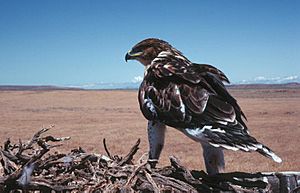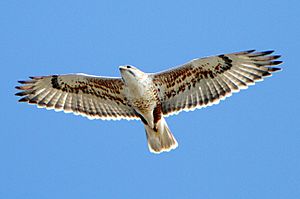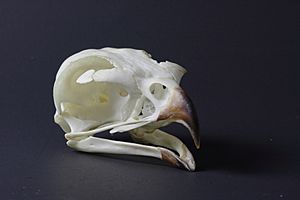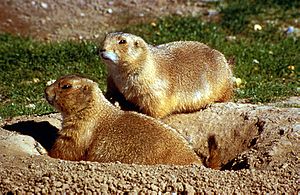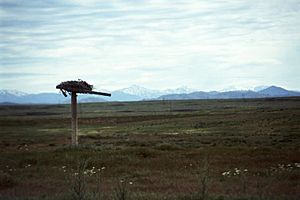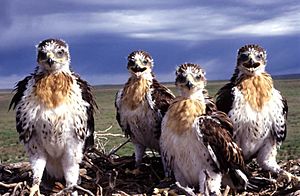Ferruginous hawk facts for kids
Quick facts for kids Ferruginous hawk |
|
|---|---|
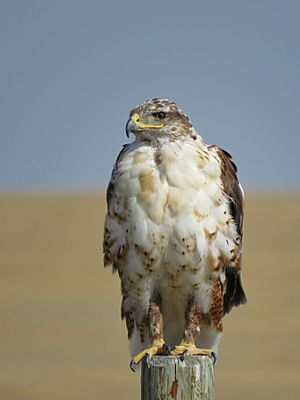 |
|
| Conservation status | |
| Scientific classification | |
| Genus: |
Buteo
|
| Species: |
regalis
|
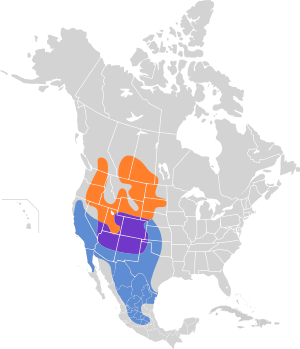 |
|
The ferruginous hawk (pronounced: fuh-ROO-jih-nuss) is a very large bird of prey. Its name comes from the Latin word for "iron" or "rusty," which describes its reddish-brown color. Its scientific name, Buteo regalis, means "royal hawk." This hawk is a type of buteo hawk, known for its wide wings. Sometimes people call it the "ferrugineous rough-leg" because it looks a bit like the rough-legged hawk.
This amazing bird lives in the open, dry grasslands, prairies, and shrubby areas of North America. It's a special bird that only lives in this part of the world. Some people even train these hawks for falconry, which is a sport where people hunt with trained birds of prey.
Contents
Description
The ferruginous hawk is the biggest Buteo hawk in North America. Because of its large size, it's often mistaken for an eagle! It has long, wide wings and a broad tail that can be gray, rusty, or white. Its legs are covered in feathers all the way down to its talons, just like the rough-legged hawk.
Female ferruginous hawks are usually bigger than males. These hawks are about 51 to 69 cm (20 to 27 in) (20 to 27 inches) long, with an average length of 58 cm (23 in) (23 inches). Their wings can spread from 122 to 152 cm (48 to 60 in) (4 to 5 feet) wide. They weigh between 907 to 2,268 g (32.0 to 80.0 oz) (2 to 5 pounds). Hawks living in colder northern areas tend to be heavier than those in the warmer south.
There are two main color types, called morphs:
- Light morph: These birds are rusty brown on their backs and pale on their heads, necks, and undersides. Their legs are rusty, and they have some rusty marks under their wings. The "ferruginous" name comes from this rusty color.
- Dark morph: These birds are dark brown all over, both on their backs and undersides. They have lighter areas on their upper and lower wings.
There are no different types (subspecies) of ferruginous hawks.
What do they sound like?
The voice of the ferruginous hawk isn't very well known. They make alarm calls that sound like kree-a or ke-ah. They also make harsh kaah, kaah calls, which are a bit like the sounds of a herring gull. Some people describe their alarm calls as "wavering" or "breathy," while others say they sound like screams, similar to the red-tailed hawk.
How to identify them
Male and female ferruginous hawks look the same, except that females are a bit larger. When perched, they have a white chest and body with dark legs. Their backs and wings are a brownish-rust color. Their heads are white with a dark stripe behind the eye. Their wingtips almost reach the end of their tails.
When flying, their underside looks mostly light-colored, and their dark legs form a "V" shape. The reddish color from their upper back extends to the inner parts of their wings, near their "shoulders." The main flight feathers (called remiges) are dark gray with clear light spots. You can also see three bright areas on their upper side: two light spots on their outer wings and a rusty patch on their rump. This rusty patch is a key way to spot a flying ferruginous hawk.
Their underwings are mostly whitish with rusty marks, especially near the bend of the wing. This gives their wings a slightly smudgy look, but less dark than a red-tailed hawk. Ferruginous hawks have noticeably longer wings than red-tailed hawks, even though their wings look thinner.
A unique feature is that the ferruginous hawk is one of only two hawks with feathers covering their legs all the way to their toes, just like a golden eagle. The other is the rough-legged buzzard. The rough-legged hawk is thinner and can be told apart by its darker colors, a wide black tail band, and a dark band across its chest.
Ferruginous hawks have very strong feet and a large beak compared to other Buteo hawks. Their grip is very powerful, showing they are excellent hunters.
Habitat
Ferruginous hawks love to live in the dry and semi-dry grassland areas of North America. They prefer open, flat, or gently rolling prairies, foothills, or middle-level plateaus that don't have many trees. They might also live near cultivated areas or along rivers where there are some trees. They avoid high mountains, dense forests, narrow canyons, and steep cliff areas.
During the breeding season, they prefer grasslands and areas with sagebrush or other dry shrubs. They build their nests in open areas or in trees like cottonwoods, willows, and swamp oaks near waterways. They usually stay away from farmed fields during this time. The more the grasslands are farmed, the fewer ferruginous hawks you'll find.
In winter, they live in similar places. However, they don't avoid farmed areas as much, especially if the crops are left standing after harvest. The leftover stubble provides homes for the small mammals they like to eat. They need places to perch, like poles, lone trees, fence posts, hills, or large rocks. Even though they nest in trees near water, water itself doesn't seem to be super important for them.
Ferruginous hawks keep a certain distance from other nesting birds of prey. The distance between their nests can vary, but it's usually about 2 mi (3.2 km) on average. They can tolerate other nests closer if they hunt in different areas. In some places, you might find one pair of hawks for every 4 sq mi (10 km2).
Behavior
The ferruginous hawk flies actively, with slow wing beats, much like a small eagle. They often soar with their wings held in a "V" shape (called a dihedral), or glide with their wings flat. They also hover in the air and fly low over the ground to hunt. Their wing beats are often described as "fluid" or smooth.
These hawks sometimes have conflicts with other large birds of prey over territories, food, or to protect their nests. They might clash with great horned owls, short-eared owls, hen harriers, red-tailed hawks, Swainson's hawks, golden eagles, accipiters, ravens, and magpies. Only larger eagles and great horned owls can usually overpower these strong hawks. While bald eagles might bother them to steal food, golden eagles can be a serious threat, sometimes even preying on them.
Interestingly, even though ferruginous hawks and red-tailed hawks might hunt in the same areas, they often eat similar prey. However, ferruginous hawks tend to focus on slightly smaller prey like pocket gophers, which golden eagles usually ignore.
Hunting and feeding
Ferruginous hawks mostly hunt small to medium-sized mammals. They also eat birds, reptiles, and some insects. Mammals usually make up 80–90% of their diet. Their diet changes depending on what prey is available in their area. Where their range overlaps, the black-tailed jackrabbit is a very important food source, along with ground squirrels and pocket gophers.
Their prey can range from tiny shrews and small bats to large black-tailed jackrabbits, which can weigh more than the hawk itself!
Here are some common foods they eat:
|
Mammals:
|
Birds: |
Reptiles: Insects: |
These hawks look for food while flying over open land or from a high perch. They might also wait quietly outside a burrow for prey to appear. They hunt at different times of the day, depending on when their prey is most active. Often, they hunt in the early morning and late afternoon.
They use several hunting methods:
- Perch and Wait: They sit on a high spot, like a pole or a hill, and wait for prey.
- Ground Perching: They stand on the ground near a rodent's burrow. When the animal comes out, the hawk pounces on it.
- Low-level Flight: They fly just a few feet above the ground, chasing prey directly.
- High-level Flight: They hunt while soaring high in the sky, though this is less successful.
- Hovering: They flap their wings quickly, especially in windy conditions, to stay in one spot and search the ground before dropping on prey.
- Cooperative Hunting: Sometimes, a pair of hawks will hunt together.
- Piracy: They have been seen gathering around hunters who shoot prairie dogs, flying down to claim the shot animals.
When they catch prey, they grab it with their feet and might strike it several times, using their back talon to pierce vital organs. They might also bite with their beak. Before taking prey to the nest, adults often eat the head. At the nest, they pluck birds and tear mammals into pieces to feed their young. They sometimes hide food, but usually not near the nest.
Reproduction and life cycle
Ferruginous hawks mate during and after they build their nests. The time they lay eggs depends on where they live, the weather, and how much food is available. In Canada, they lay eggs from late April to late June. Farther south, they lay eggs from late March to mid-May. Eggs are laid every two days, and incubation (keeping the eggs warm) starts when the first egg is laid. Both parents share the incubation duties, which lasts about 32 days. It's rare for them to lay new eggs if their first clutch fails.
Courtship flights are not very detailed. Both male and female hawks fly in high circles. These soaring flights might be more about defending their territory than showing off for a mate. They also have a "flutter-glide" flight, which is a series of quick wing beats mixed with short glides, possibly to show other hawks that the territory is taken. If another hawk enters their territory, they might do a "sky-dance," which involves slow flight with deep, hard wing beats and irregular movements, sometimes ending in steep dives.
The hawks often perch in high, noticeable places around the nest, especially early in the breeding cycle. They can be aggressive, attacking or chasing other birds. Mating starts before the new nest is finished and happens more often until the eggs are laid. The male might bring food to the female before mating.
Ferruginous hawks are very flexible about where they build their nests. They will use trees, ledges, rock or dirt outcrops, the ground, haystacks, special nesting platforms, power poles, and other man-made structures. Tree nests are usually in single trees or small groups of trees in open areas. Ground nests might be more at risk from animals like coyotes. They often reuse nest locations, and a pair might have one or two extra nests in their territory, though some have been found with up to eight!
They build their nests from things they find on the ground, like sticks, branches, and cattails. They will fix up old nests or take over nests from other birds, adding more sticks. Sometimes they even use strange items like paper, trash, barbed wire, cornstalks, plastic, and steel cable in their nests! They line their nests with tree bark, grasses, and cow dung. They also add fresh green plants. In the past, when bison roamed, they would use bison bones, fur, and dung for nesting material. Both parents help build the nest, but the male often brings the materials, and the female arranges them.
The number of eggs they lay can be from one to eight, and it usually depends on how much food is available. On average, they lay three to four eggs. Each egg is about 2.5 in (64 mm) long and 2 in (51 mm) wide. They are smooth, not shiny, and whitish, with irregular spots or blotches of reddish-brown. Sometimes the eggs are almost plain or have faint marks.
The chicks stay in the nest for 38 to 50 days. The female usually does most of the brooding (keeping the chicks warm). Male chicks leave the nest (fledge) at 38 to 40 days, while females take longer, up to 50 days. For the first two weeks, the nestlings lie or sit. By about three weeks, they can stand, and soon after, they can walk. By 16 or 18 days, they can feed themselves. They start flapping their wings around day 23, and by day 33, they can flap strongly and make "flap jumps." Young hawks are sensitive to high temperatures and will try to find shade in the nest.
The first time they leave the nest might be because they are too hot and are looking for shade. After they fledge, young hawks depend on their parents for several weeks. For the first month after leaving the nest, they explore larger areas around the nest as they learn to hunt. Some young hawks have caught prey as early as four days after fledging.
Ferruginous hawks usually have only one brood (set of young) per year. The number of young that survive is closely linked to how much food is available. In areas where jackrabbits are the main food, the number of eggs laid and young raised changes with the jackrabbit population. If there are few jackrabbits, half the young might not survive. In years with lots of food, 2.7 to 3.6 young per nest have been reported. Their ability to lay many eggs means they can quickly have more young when food is plentiful.
Ferruginous hawks have been known to live for 20 years in the wild, but most probably die within their first five years. The oldest banded hawks were found at age 20. About 66% of young hawks die in their first year, and about 25% of adults die each year. They can die from illegal shooting, not enough food, being bothered by humans, or being hunted by other animals. Ground nests can be attacked by coyotes, bobcats, and mountain lions. Young hawks and adults can be hunted by great horned owls, red-tailed hawks, bald eagles, and golden eagles.
Status and conservation
In the past, the ferruginous hawk was sometimes considered a threatened or endangered bird. However, their numbers have increased in some areas recently, and conservation efforts have given hope for their future. The IUCN used to list them as "Near Threatened," but new research shows they are common and widespread again. So, in 2008, their status was changed to "Least Concern" (meaning they are not currently at high risk).
Their numbers declined mostly because they lost their natural habitat. Even though they can adapt to different nest sites and have many young, they need natural grasslands for breeding and specialized prey (like prairie dogs) that are sometimes hunted by humans. Historically, they completely disappeared from areas where farming replaced natural plants and animals. For example, in 1916, they were almost extinct in San Mateo County, California.
Studies show that prairie dogs are a main food source for ferruginous hawks. This means the hawks are linked to the populations of prairie dog towns, which have been declining in the central and southwestern United States. These birds might also be sensitive to pesticides used on farms, and they are sometimes shot.
Here are the main threats to the ferruginous hawk population:
- Farming of native prairie grasslands, which destroys their habitat.
- Trees growing into northern grassland habitats.
- Less food available because of pest control programs on farms.
- Shooting and human disturbance.
The ferruginous hawk was once on the National Audubon Society's "Blue List" of species that were declining. From 1971 to 1981, it stayed on this list, and from 1982 to 1986, it was a species of "Special Concern." Various states in the U.S. have listed it as "Threatened" or "Endangered." In Canada, it was considered "Threatened" in 1980.
In the Canadian prairies, their range was shrinking until 1980, and they were thought to occupy only 48% of their original area. Their numbers were generally decreasing, with an estimated 500 to 1000 pairs in Canada. However, by 1987, their population started to increase. The Alberta population alone was estimated at 1,800 pairs. This increase was probably due to more food being available in their wintering areas, which helped the birds be healthier when they returned to Canada to breed. In the United States, there has been concern about this species, but in 1988, one study suggested that the population in California and other local areas might have grown a lot.
Harmful chemicals like pesticides have not been a major threat to the ferruginous hawk. To help these birds, we need to keep or restore native grasslands for them to breed and spend the winter. Making sure there's enough prey in wintering areas is also very important for the hawks to be ready to breed in the summer. It's crucial to include farming practices and policies in conservation plans. Providing nesting platforms has helped them, and public education to stop persecution and human disturbance is also a key part of protecting these magnificent birds.
Use in falconry
The ferruginous hawk is a highly respected bird for falconry. However, it's not suggested for beginners because of its large size, strength, and bold personality. For experienced falconers, it's a great way to experience hunting with a bird similar to a golden eagle, but with less risk of injury to the falconer.
These hawks are faster and stronger than the red-tailed hawk. They are very good at catching larger hares and black-tailed jackrabbits, which are difficult prey for red-tailed hawks and Harris's hawks. With their agility, they are also more effective at hunting large bird species than a golden eagle.
- Part of this article incorporates text from the Bureau of Land Management, which is in the public domain.
See also
 In Spanish: Busardo herrumbroso para niños
In Spanish: Busardo herrumbroso para niños



